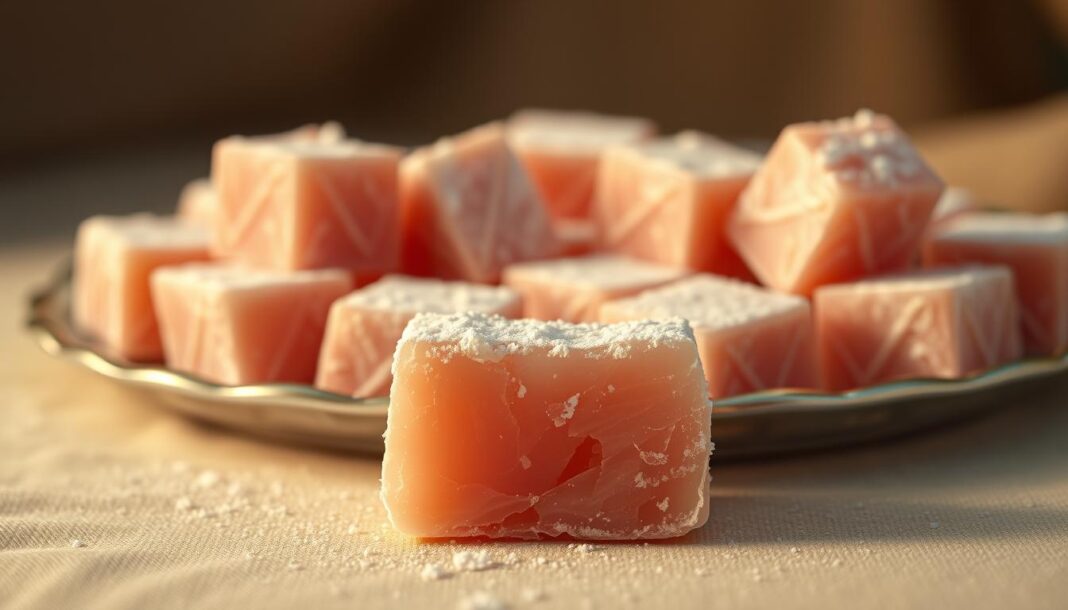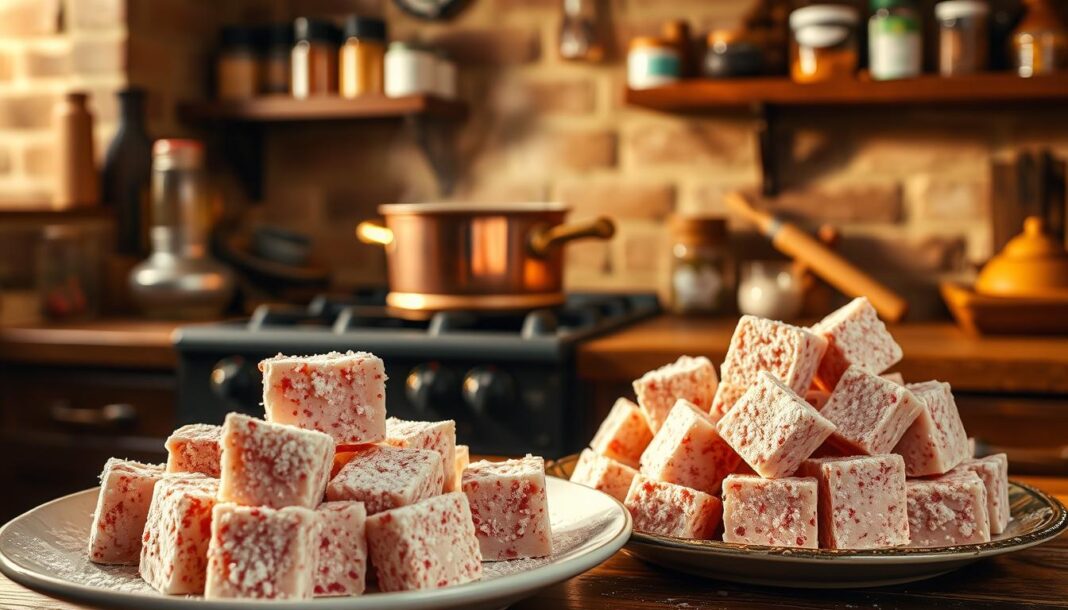We’re delving into the enchanting world of Narnia treats, focusing on the iconic Turkish Delight that tempted Edmund Pevensie in C.S. Lewis’s beloved Chronicles of Narnia.
This magical confection, also known as lokum, represents more than just a sweet treat—it symbolizes temptation and betrayal, making it one of literature’s most memorable food moments.
To recreate this legendary sweet at home, understanding the proper temperature control and cooking time is essential for achieving the perfect texture.
The basic ingredients—sugar, water, and cornstarch—transform through a precise cooking process into a uniquely textured mixture.
Key Takeaways
- Explore the historical context and literary significance of Turkish Delight in Narnia.
- Learn about the origins of Turkish Delight in the Ottoman Empire.
- Understand why C.S. Lewis chose Turkish Delight for his narrative.
- Discover the importance of temperature control in making Turkish Delight.
- Find a tested recipe to recreate authentic Turkish Delight at home.
The Magic of Narnia Desserts in C.S. Lewis’s World
In the realm of Narnia, crafted by C.S. Lewis, desserts are not just treats but also tools of temptation and enchantment. The Chronicles of Narnia series is renowned for its vivid descriptions of magical lands and characters, with “The Lion, the Witch and the Wardrobe” standing out for its memorable depiction of sweets.
Edmund’s Temptation and the White Witch
Edmund Pevensie’s encounter with the White Witch in “The Lion, the Witch and the Wardrobe” centers around his temptation by Turkish Delight, a scene that has become one of literature’s most memorable food moments. The White Witch uses this candy, made almost entirely of sugar, to manipulate Edmund, symbolizing how easily we can be seduced by immediate pleasures at the expense of long-term relationships and moral integrity.
Why Turkish Delight Was the Perfect Literary Choice
C.S. Lewis’s choice of Turkish Delight was particularly significant given the historical context; he wrote during post-WWII Britain when sugar and confectionery were strictly rationed. This made Turkish Delight an especially luxurious and tempting treat. The exotic origins and ingredients of Turkish Delight made it a perfect literary device, mysterious enough to seem magical to British children. This has inspired numerous recipes attempting to recreate the magical treat.
The Fascinating History of Turkish Delight
Turkish Delight, known as ‘lokum’ in Turkish, has a storied past that is both intriguing and complex. The confection’s history is intertwined with the cultural and culinary traditions of the Ottoman Empire.
Origins in the Ottoman Empire
The origins of Turkish Delight are shrouded in mystery, with competing historical narratives. Some historians trace it back to the Persian confection “ahbisa,” while others place its invention in 18th century Ottoman Istanbul. One compelling story suggests that Sultan Abdülhamit I requested a softer candy than what was available, leading to the creation of Turkish Delight. The name “lokum” comes from the Arabic phrase “rahat-ul hulküm,” meaning “comfort for the throat.” Discover more about making Turkish Delight.
How Turkish Delight Reached Western Culture
Turkish Delight made its way to the West in the 19th century when travelers brought it back from Istanbul. Official importation to England began in 1861, initially marketed as “Lumps of Delight.” The confection’s popularity grew as it became known for its unique texture, achieved by using sugar and cornstarch. Today, Turkish Delight is enjoyed worldwide, appreciated for its rich history and cultural significance.
| Year | Event | Location |
|---|---|---|
| 15th Century | Possible origins of lokum | Persia/Middle East |
| 18th Century | Invention of Turkish Delight | Istanbul |
| 1861 | Official importation to England | England |

Authentic Narnia-Inspired Turkish Delight Recipe
To bring a taste of Narnia to your kitchen, we present an authentic Turkish Delight recipe inspired by C.S. Lewis’s iconic descriptions. This confection, known as “lokum” in Turkish, is a delicate balance of flavors and textures that will transport you to the magical land of Narnia.
Essential Ingredients for Perfect Lokum
The ingredients for our Narnia-inspired Turkish Delight are simple yet crucial for achieving the perfect texture and flavor. You will need:
- 350g (scant 2 cups) white sugar
- 175ml (¾ cup) water (for syrup)
- 1.8g (¼ teaspoon) citric acid
- 70g (½ cup + 1 tablespoon) cornstarch
- 500ml (2 cups + 5 teaspoons) water (for cornstarch)
- 1½ teaspoons rosewater
- 10 drops of red food coloring
For cutting and dredging, you’ll also need cornstarch and powdered sugar. The quality of these ingredients is important; for instance, using regular white sugar is recommended as it affects the final cooking stages.
| Ingredient | Quantity | Purpose |
|---|---|---|
| White Sugar | 350g | Sweetness and texture |
| Cornstarch | 70g + 30g + 80g | Thickening and dusting |
| Rosewater | 1½ teaspoons | Flavoring |
Equipment You’ll Need
To prepare this Turkish Delight, you’ll need a few essential pieces of equipment: a heavy-bottomed pot to prevent scorching, a candy thermometer for precise temperature control, and a 9×9 inch mold for setting the mixture.
Preparation Steps
The preparation process requires attention to detail. Start by dissolving the sugar completely in water to create a syrup. Then, prepare a lump-free cornstarch slurry. Combine these mixtures and cook to the soft ball stage (250°F), ensuring the perfect chewy texture. Finally, flavor with rosewater and color with red food coloring.

By following these steps and using the specified ingredients, you’ll be able to create approximately 40 one-inch cubes of Turkish Delight, perfect for sharing or gifting. The result is a transcendent confection that connects you directly to both culinary history and literary magic.
Step-by-Step Cooking Instructions
The cooking process is where the magic happens – let’s get started with making our Turkish Delight. To achieve the perfect lokum, we’ll guide you through each crucial step.
Creating the Sugar Syrup Base
Begin by combining sugar, citric acid, and water in a heavy-bottomed pan. Heat the mixture on high until the sugar dissolves, then bring it to a boil. Reduce the heat to a simmer and wait until the syrup reaches 250°F, using a candy thermometer to monitor the temperature. This process typically takes 15-30 minutes, depending on your stove’s heat output.
Preparing the Cornstarch Slurry
While the syrup is heating, prepare the cornstarch mixture by combining cornstarch and cold water in a jar. Shake vigorously until the mixture is smooth and free of lumps. Alternatively, you can mix it thoroughly in a separate bowl.
Combining and Cooking the Mixture
Once the syrup reaches 250°F, turn off the heat and gradually add the cornstarch slurry, whisking continuously. Return the mixture to medium-low heat and continue whisking until it thickens. Then, reduce the heat to low and simmer for 1-2 hours, stirring every 7-8 minutes to prevent sticking. The mixture is done when it reaches a medium-dark amber color and a thick but not gloopy texture.
| Cooking Stage | Temperature | Time |
|---|---|---|
| Sugar Syrup Base | 250°F | 15-30 minutes |
| Cornstarch Slurry Addition | – | – |
| Simmering | Low heat | 1-2 hours |
Mastering the Art of Turkish Delight
To make authentic Turkish Delight, one must understand the science behind sugar cooking and temperature control. This confectionery requires precision and a nuanced approach to achieve the perfect texture and flavor.
Temperature Control Techniques
Temperature control is critical when making Turkish Delight. We recommend using a reliable candy thermometer to monitor the sugar mixture temperature, aiming for the ideal range of 250°F to 260°F. The Turkish Delight recipe relies on reaching the soft ball to hard ball stage for the perfect texture.
Achieving the Perfect Texture
The perfect lokum texture depends on several factors, including proper sugar temperature, correct cornstarch-to-sugar ratio, and gentle stirring during cooking. Preventing lumps is crucial, and our method of gradually adding a well-shaken cornstarch slurry to the hot syrup while continuously whisking eliminates lumping problems.
Troubleshooting Common Issues
Common issues with Turkish Delight include not setting, lumpy texture, and overly hard candy. If your Turkish Delight isn’t setting, it may be due to insufficient cooking temperature or time. For lumps, ensure that you add the cornstarch slurry gradually.
Flavor Variations Beyond Rose
While rosewater is a classic flavor for Turkish Delight, we can explore other traditional and creative options. The world of lokum is diverse, offering a range of flavors that can cater to different tastes and preferences.
Traditional Turkish Flavors
Authentic Turkish Delight comes in a variety of traditional flavors, including lemon, mastic, orange, and plain. Some recipes also incorporate chopped nuts like pistachios or walnuts, adding texture and depth to the Turkish Delight. For instance, you can try using different nut flavors to create unique variations.
Narnia-Inspired Creative Options
For a Narnia-inspired twist, consider flavors that evoke the snowy landscape of C.S. Lewis’s world, such as peppermint or wintergreen. You can also experiment with subtle vanilla-cinnamon blends or other creative flavor combinations. When using flavor extracts, remember that they are often stronger than rosewater, so start with half the recommended volume and adjust to taste. Don’t forget to customize the color of your Turkish Delight to match the flavor, using food coloring that suits your brand and style.
Serving and Storing Your Magical Treats
Once you’ve made your Turkish Delight, learning how to serve and store it will enhance your experience. To serve, arrange the Turkish Delight pieces on a decorative cutting board or platter, and dust with a little bit of powdered sugar on top for a snow-like effect. Traditionally, Lokum is enjoyed with Turkish coffee and water. For storage, keep it in an airtight container with cornstarch and powdered sugar to prevent sticking. Make sure to bring it to room temperature before serving.


